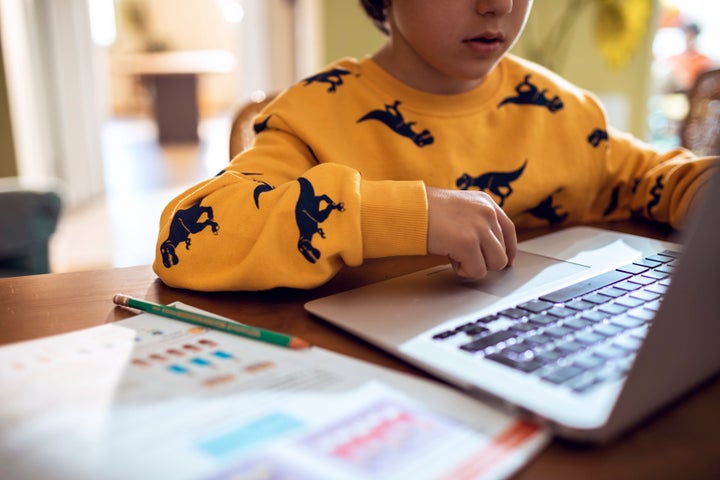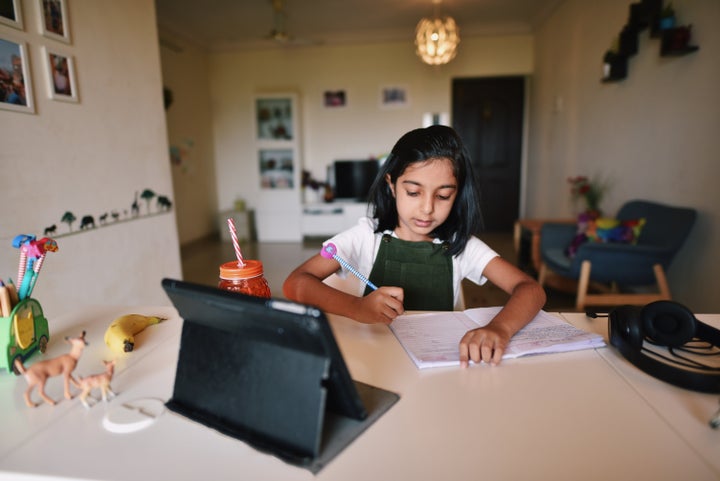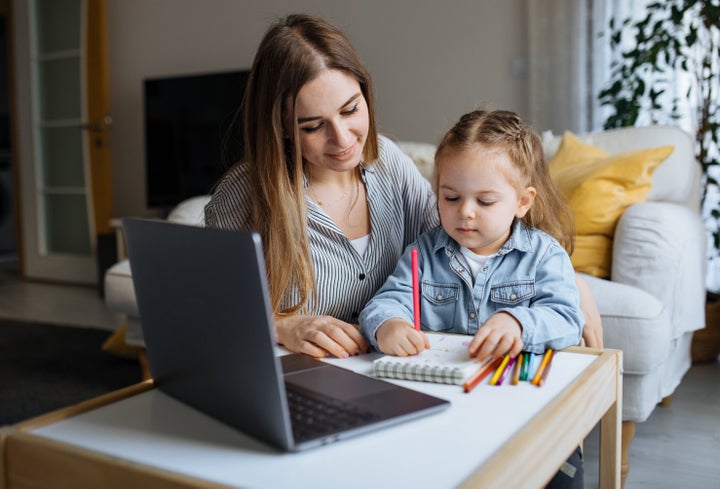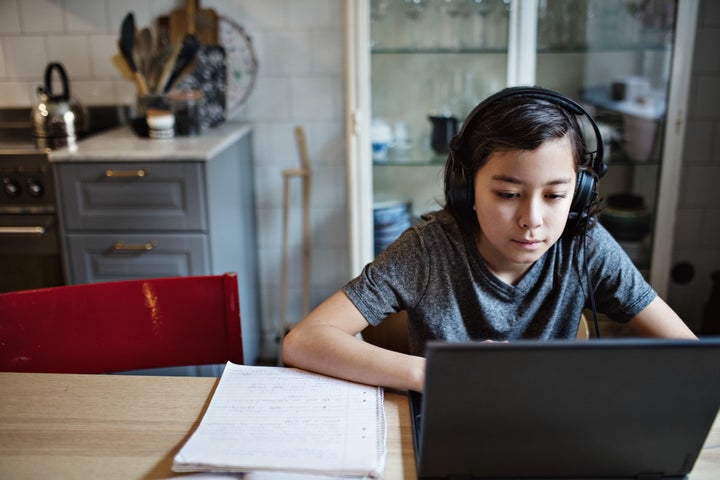
At this point in 2020, parents, students and teachers can confidently say that remote learning is challenging, to put it mildly. One big issue is the experience doing class via video conference and the anxiety it can provoke among kids.
“Students might be worried about how they appear on camera or what their background looks like and what their peers are thinking,” Jessica Foster, a developmental and behavioral pediatrician at Akron Children’s Hospital, told HuffPost. “Answering a question in a Google classroom can induce performance anxiety. It can be harder to feel a connection to the teacher and to the other students in the room. Our nonverbal communication, such as supportive nods and smiles of encouragement from other kids and the teacher, can be lost or hard to see in video conferencing.”
“Encouraging comments from peers that might occur in an in-person classroom setting can also be missing in a video format,” she added. “If the student has difficulty with consistent internet access or struggles using the video conferencing platform, this can also lead to stress and worry that may impact a child’s participation online.”
For a child who is shy, these additional challenges can make classroom participation feel impossible. Even students who aren’t shy in person may feel much more reserved and less inclined to participate on-screen, potentially hampering their learning experience.
So what can parents do to help a child who is struggling with shyness in the age of remote learning? Read on for advice from Foster and other experts.
Ask them about it.
“One of the first steps to helping students who are shy on camera is to learn why they are shy,” said Isaiah Pickens, a clinical psychologist and the CEO of iOpening Enterprises. “Students could be shy because they are naturally introverted, or be driven by fear or anxiety that is focused on how the house looks, feeling like they will be made fun of, worry about the coronavirus or a number of other reasons. To provide the age-appropriate support, it begins by discovering why children are shy about getting on camera.”
Rather than make a big deal of it, parents and caregivers can tee up this conversation in a calm, comfortable way by bringing it up while driving, cooking dinner or drawing together. Show curiosity, focus on listening and try not to make their child feel judged.
“Let them know that it’s a totally new situation for everyone and that it’s OK to mess up. Learning comes from mistakes!”
- Sarah Brown Wessling, 2010 National Teacher of the Year
“You can say, ‘I notice that you can be shy or quiet in front of screen/video learning. Is that true? Can you tell me why?’” suggested Nuanprang Snitbhan, a clinical psychologist who works with families and creator of Kindness Cards for Kids: 52 Ways to Make Every Day a Little Better.
“Ask your child what about the experience feels most ‘scary’ or uncomfortable to him/her,” advised psychologist Sanam Hafeez. “Don’t ‘accept’ nondescript answers such as, ‘I just don’t like it.’ Get to the root of what they dislike.”
Validate their feelings.
Once your child expresses their concerns, let them know it’s OK to feel nervous, anxious, insecure, disheartened or whatever emotion they’re experiencing.
“It is quite natural to feel self-conscious about being on camera, and it is important to validate your child’s feelings about this,” said licensed clinical psychologist Cindy Graham.
You should also show support and make it clear that you will do your best to help them through this situation.
“Parents should be understanding of why their child is having a hard time being on the camera,” said Sarah Brown Wessling, 2010 National Teacher of the Year and Johnston High School English teacher who has been working with the video communications company Prezi to help teachers and students adjust to distance learning. “Let them know that it’s a totally new situation for everyone and that it’s OK to mess up. Learning comes from mistakes!”

Remind them they’re not alone.
“Remind your child that she’s not the only one who feels this way,” advised Foster. “Everyone is going through this new learning curve together ― parents, kids and teachers.”
In addition to making your child feel less alone in feeling anxious or nervous, parents can also assure them that their classmates probably aren’t watching and scrutinizing them as much as they fear.
Graham suggested using the Selective Attention Test, an exercise that reminds us what our brains do and don’t observe in a given moment.
“It is a great way to show kids that people do not notice nearly as much about what is going on around them as we worry they do,” she said. “Reassure your child that while they may be more aware of their own actions, the students also in the remote learning classroom are not noticing so much.”
Create a comfortable learning environment.
Parents can ensure the space where their child does remote learning is pleasant and comfortable.
“Introduce the idea of creating a safe and relaxing learning space by asking them to help you brainstorm what to bring to this area ― for example, fidget toys, an encouragement rock, a relaxing image of one’s favorite place, a weighted lap blanket, low-sugar mint candies, a lavender pillow, etc,” said Snitbhan.
Parents can also offer to be in the same room off-screen for a couple of classes, at least at the beginning to help them feel support as they get comfortable. The presence of a favorite toy or mellow pet off-screen may also help.
Foster noted that kids may be self-conscious about their background or sensitive to what’s happening behind them, so parents can help them choose a classroom-appropriate spot ― whether at their house or in a public space or facility with internet for those who don’t have access at home.
“Knowing ahead of time what you look like on screen including what will show in your background gives you a chance to get comfortable and make adjustments,” she explained. “Kids should also work with their family to find a space that is quiet with as few distractions as possible ― this may be quite challenging if there are multiple remote learners at home and can also be a challenge in small spaces, so this may require some planning and creativity to get kids through each school day!”
“As educators and caregivers, we need to teach our kids to advocate for their needs with remote learning, whether they are shy or not.”
- Megan Allen, 2010 Florida Teacher of the Year and founder of Tailored Learning Supports for Families
She also noted that being prepared for class always makes a child feel more confident.
“Make sure all of your children’s supplies and books are right there where they need them before the start of class, and muting distracting background noises will help your child stay on task and be more engaged,” she advised.
Talk to the teacher.
“Your student may be able to talk directly and frankly offline with their teacher about what they are experiencing, what is making online learning hard for them and they can problem solve together, ” Foster noted. “Depending on their age or the specific situation, the parent may also need to get involved to help talk with the teacher and make a plan.”
Communicating directly and regularly with your child’s teachers fosters helpful collaboration as you can brainstorm different approaches to try. You may explore new options for helping your student engage in the classroom and set goals together. Your child could request to log on early or stay on after class ends to form a more direct connection.
“As educators and caregivers, we need to teach our kids to advocate for their needs with remote learning, whether they are shy or not,” said Megan Allen, 2010 Florida Teacher of the Year and founder of Tailored Learning Supports for Families. “It’s all so different from a four-walled classroom. We need to teach them to speak up with a question, raise their hand if they can’t hear, and on the other side, share the airtime in a collaborative learning space. If they are too shy to do so in front of the whole class, I’d suggest working out a secret sign with the teacher. That way they can advocate for their needs in a way that they feel comfortable.”
Turn off the camera when possible.
A useful question to ask teachers is if it’s possible for students to turn off their cameras during class so that they don’t get distracted staring at their own appearances.
One option is to turn the camera off after roll call and just use a profile picture or name as an avatar. Another is to ask for breaks from a camera requirement throughout the day. There’s also the option to simply adjust the camera view.
“I have recommended to several families with children who just don’t want to have the camera on during class, but need to follow school protocol, to position the camera where it doesn’t show their full face,” said Meredith Essalat, a school principal and author of “The Overly Honest Teacher.”
“Adjusting the screen placement to show that they are working and engaged without having their face on display is a great compromise in having students partake in the accountability of being online and participating with their classmates in whatever subject they are studying, while feeling a bit more sense of privacy and security in shrouding their face,” she added.
Graham offered another solution: “Cover the image of themselves. This can be done with a sticky note or by changing the tile options to only have the speaker on-screen.”

Practice, practice, practice.
“As much as we usually encourage our children to stay off devices, if you have a child who is camera shy on remote learning, perhaps have them spend some time Facetiming with a friend just to get used to the concept of ‘video talking’ during a more relaxed time,” Hafeez suggested.
Testing out FaceTime, Zoom or other video conferencing platforms with friends and family can help kids acclimate to being on-camera, hitting different buttons like “mute,” and entering breakout rooms. This practice will boost their confidence by showing them they can successfully use these tools ― and even have fun while doing it. If they’re still struggling with shyness, start with short conversations and build from there.
“Using roleplay to help your child learn how to navigate and become familiar with the videoconferencing functions can also reduce their stress and anxiety,” Foster said. “Practice makes perfect, and soon it will become second nature to participate in class on camera. The more you raise your hand and give it a try, the more comfortable you will feel participating. If your child knows they are sharing something in class beforehand, practicing can help ease anxiety.”
“If you have to employ a few extended family members to do a ‘mock classroom’ with someone functioning as the teacher and others as the students, this would be ideal,” added Hafeez.
Ease into it with small goals.
“Parents can work with students to collaboratively explore ways to ease into camera use or find additional ways to engage in the class such as through email, the chat, or even providing the teacher recorded responses,” Pickens said. “By working with children to find solutions, parents empower children to build skills that they may not be aware of having and challenge beliefs students have that make being on camera more difficult such as believing other students are laughing at them.”
“Instead of thinking about what can go wrong and what other people think, students can focus on the ways they can participate whether it is through a chat, a small group or even asking for a conversation with the teacher at a different time.”
- Wessling
Many experts suggested using the chat box feature as a way for kids to show that they are engaged and eager to contribute without having to speak out loud on camera. This may also make them feel more comfortable participating and ease into more active forms of engagement.
“Changing the narrative in their own minds can help students break through the barriers of nervousness,” Wessling explained. “Instead of thinking about what can go wrong and what other people think, students can focus on the ways they can participate whether it is through a chat, a small group or even asking for a conversation with the teacher at a different time.”
Parents can also encourage their kids to step outside their comfort zones by setting a personal goal of speaking up at least once every class, she added.
“I also think parents can help their child understand that teachers are expected to monitor the level of attentiveness in the students whether they are live in-person or in a remote-learning situation, and that if the child can show up in the chat, then perhaps they can slowly turn on their camera for small amounts of time,” said Elizabeth Milovidov, a law professor and digital parenting expert with Tone Networks. “Continuing this kind of routine exposure to responding in chat / in video may be mildly uncomfortable, but the smaller doses should demonstrate to the child that they can handle it.”
Offer positive feedback.
As your kids set small goals and ease into more active participation, be sure to offer genuine positive feedback about the progress and attempts they’re making along the way.
“You can say, ‘I know it is hard, but I also know you can do hard things,’” said Snitbhan. “Be careful not to make any comparison or only focus on the result. Process matters!”
Graham emphasized the importance of being positive and hopeful, rather than negative, and reminding children of their resilience.
“Instead of saying to your child, ‘Yes, it is embarrassing to be on-screen and have everybody looking at you,’ try saying, ‘Many people feel shy to see themselves on camera. I’m proud of you for continuing to turn on your camera in spite of the discomfort. Let’s talk about how we can make this more comfortable for you,’” she said.

Try self-soothing techniques.
“Whenever students encounter situations that are stressful or outside of their comfort zones, these are opportunities for growth and the development of life skills,” Essalat said. “It’s crucial to their ability to be able to handle life’s future bumps and jostles that they know, confidently, they have the tools and strategies to self-soothe and problem-solve.”
She suggested implementing breathing techniques to calm nerves and relax the body, uplifting family mantras to feel empowered, and visualization of safe spaces or nurturing memories to divert the mind’s focus from the fearful to the familiar.
Pickens shared some other helpful coping skills that kids can use to ease stress and anxiety about talking on-screen.
“Let yourself know that it is okay to feel nervous, scared, or stressed because other people feel that way sometimes too,” he said. ”Remember times in the past that you felt scared, nervous, or stressed and actually still did the difficult thing and it didn’t go as bad as you thought it would. Practice saying encouraging words in your head to yourself as if someone else is encouraging you. Saying ‘This is tough, but I’m up for it’ or ‘I actually like being with the rest of the students and can do it for at least a little while on camera’ can help build confidence to be on camera.”
If the situation becomes more severe or your child shows signs of serious social anxiety, it may be worth seeking the help of a mental health professional to help them cope.
Be patient and give it time.
“It’s important not to make this bigger than it is and be confident in your child’s ability to adapt with support,” said psychotherapist Noel McDermott. ”Unless your child has specific conditions that affect their ability to adapt naturally then they will adapt, it is how children in particular are designed.”
He emphasized the importance of trusting educators in their expertise and follow their lead in navigating this new situation. It’s still relatively early in the school year, so there’s time to work through the growing pains and forge connections between educators and students.
Meghan Fitzgerald, an educator who founded the outdoor early learning program Tinkergarten, said she tries not to use the term “shy” because it can have negative connotations and sound more fixed than it is. Instead, she sees them as “choosing to take an ‘onlooker’ stance” in new situations.
“First and foremost, be patient and give kids that time to observe, assess and adjust to the new online classroom environment,” said Fitzgerald. “And, do not assume that kids are getting a lesser experience if they choose to look on for a while. If you are concerned, chat casually with kids after the session ends and ask what they did, saw, heard and learned. You’ll likely be surprised at how much they got out of it. Try not to ask questions that indicate to kids that you thought they didn’t enjoy it ― they’ll likely pick up on your slant and start to worry too.”
As multiple experts noted, it’s helpful to keep a few things in mind while dealing with this confusing school year: We’re all just trying our best, we’re all in this together, and we’re getting stronger.
“Remote learning will certainly never replace the vibrance that comes from in-person, on-campus education, but if we can use it as a catalyst for academic and personal growth during this time of pandemic, our students will be better, long-term, because of its implementation,” said Essalat. “We just have to be willing to exercise both creativity and compassion when strategizing ways with our more reticent students to make remote learning an effective and amenable tool in their academic success.”